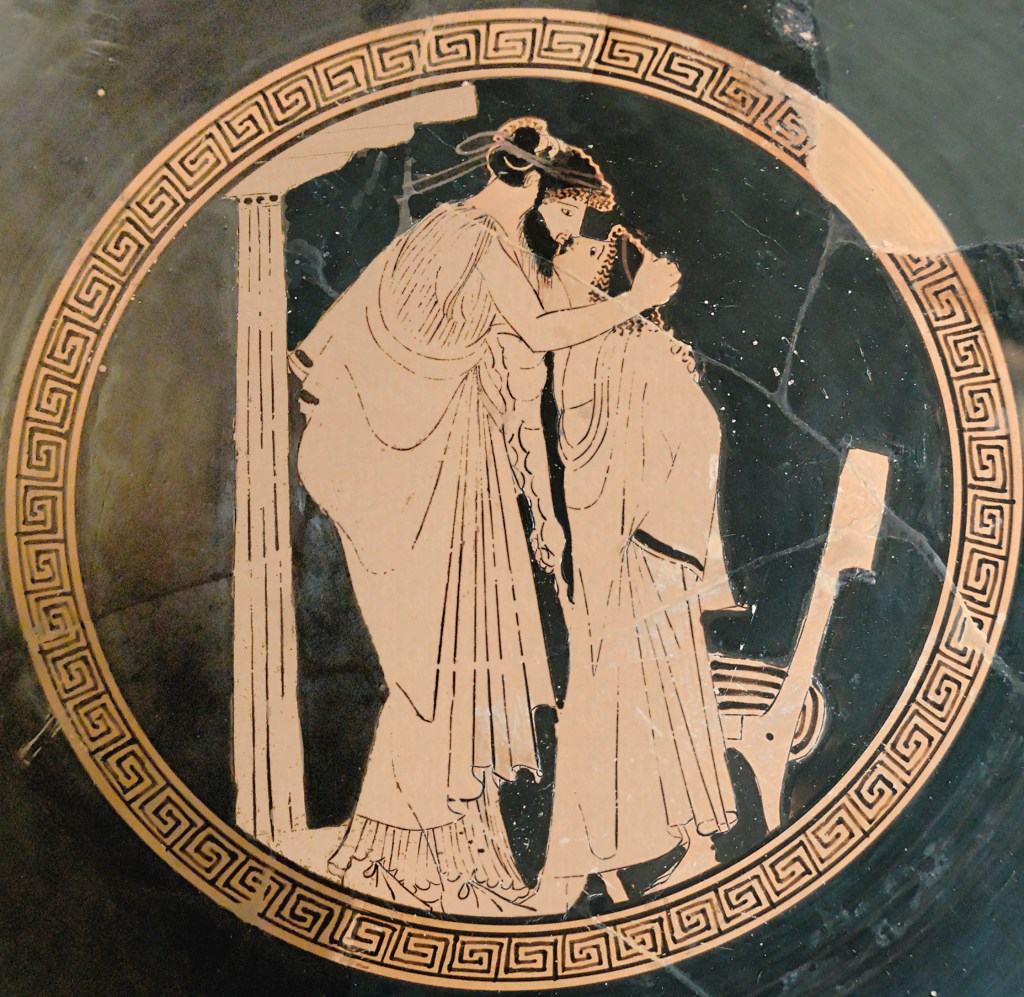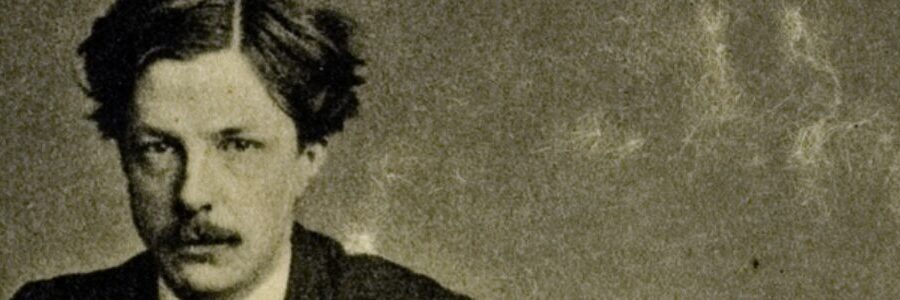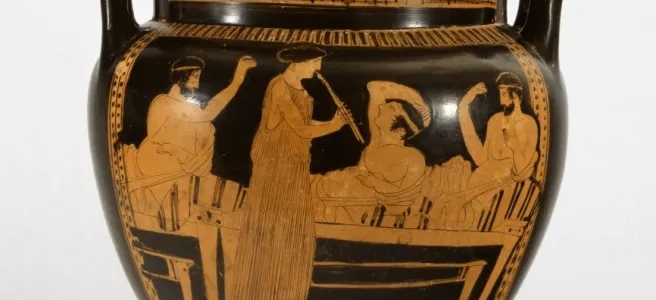To say that Symonds was disgusted by the version of homosexuality that he saw at Harrow is an understatement. Symonds saw the relationships at Harrow as brutal and vulgar, which eventually led him to discover Plato and the idealized form of homosexuality that the Platonic dialogues espouse (Memoirs, 152). However, the comfort that Symonds found in Plato might not have been merely a more elegant form of homosexuality. Looking at Pausanias’s speech in the Symposium, what Symonds might have seen and rejected in the relationships at Harrow was not only a more carnal form of homosexuality but one that he saw as pantomiming the binary relationships of heterosexuality, making Symonds’s disgust an early rejection of heterosexuality itself.
Taken at face value, Symonds’s disgust towards the sexual goings-on at Harrow seems primarily directed at their carnality. Consider the language that Symonds used in the Memoirs to describe what he saw:
The earliest phase of my sexual consciousness was here objectified before my eyes; and I detested in practice what had once attracted me in fancy.…The animalisms of boyish lust sickened me by their brutality, offended my taste by their vulgarity. I imagined them to be a phase of immature development, from which my comrades would emerge when they grew to manhood. Nevertheless, they steeped my imagination in filth.
Memoirs, 149
Symonds’s disgust here seems primarily directed at the animalistic and juvenile nature of what he witnessed at Harrow. If Symonds’s disgust here is directed solely at the carnality of the acts, the important distinction between the love Symonds read about in the Platonic dialogues and the acts he witnessed at Harrow is merely the difference between two versions of homosexuality: the more carnal version he witnesses at Harrow and the more idealistic version he reads about in the Symposium. In this “carnality” reading of Symonds’s disgust, the comfort that Symonds then finds in the Symposium is an affirmation of his more innocent homosexuality. However, there might be another part to the story. Looking at Pausanias’s speech in the Symposium, what Symonds saw at Harrow and reflected in Plato might have been not only the distinction between a “cruder” and “purer” form of homosexuality but a distinction between a pure form of homosexuality and one that mimicked heterosexuality. For Symonds, what he saw at Harrow was not only carnal; it also reflected the gendered, binary relationship of heterosexuality.
In the Symposium, Pausanias makes a distinction between heavenly love and common love. Heavenly love, for Pausanias, is “from the male only,” as those that participate in heavenly love “turn to the male, and delight in him who is the more valiant and intelligent nature,” with heavenly love also being concerned with the well-being of those involved (Symposium, 181c-d). Meanwhile, consider how Pausanias describes common love:
The Love who is the offspring of the common Aphrodite is essentially common, and has no discrimination, being such as the meaner sort of men feel, and is apt to be of women as well as of youths, and is of the body rather than the soul – the most foolish beings are the objects of this love which desires only to gain an end, but never thinks of accomplishing the end nobly, and therefore does good and evil quite indiscriminately. The goddess who is his mother is far younger than the other, and she was born of the union of the male and the female, and partakes of both.
Symposium, 181a-c
Here, Pausanias notes that common love is not only more brutal than its heavenly counterpart, but it is also more concerned with ends and is uniquely tied to heterosexuality. Meanwhile, heavenly love is an idealized non-carnal love, one that is innately homosexual. Therefore, the distinction between the two is not only one of carnal and non-carnal, but also one of homosexuality and pantomimed heterosexuality, where the former is concerned with the well-being of those involved and the latter only concerned with the pleasure of the lover.
There are echoes of Pausanias’s distinction in the way that Symonds described the goings-on at Harrow. Consider the passage with which Symonds begins the fifth chapter of his Memoirs:
One thing at Harrow very soon arrested my attention. It was the moral state of the school. Every boy of good looks had a female name, and was recognized either as a public prostitute or some bigger fellow’s ‘bitch.’ Bitch was the word in common usage to indicate a boy who yielded his person to a lover. The talk in the dormitories and the studies was incredibly obscene. Here and there one could not avoid seeing acts of onanism, mutual masturbation, the sports of naked boys in bed together. There was no refinement, no sentiment, no passion; nothing but animal lust in these occurrences. They filled me with disgust and loathing.
Memoirs, 147
Upon first glance, this passage is merely Symonds describing his disdain for the homosexual culture at Harrow. However, in this passage, Symonds also makes note of parts of the Harrow homosexual culture that mimic the gendered relationship of heterosexuality. In particular, he notes that more submissive, good-looking boys were given female names, recognized as prostitutes, and were referred to as the “bitch” of a more dominant boy. These are aspects of Harrow’s culture that Symonds not only described as crude, but that he distinctly linked with the traditional gendered power relationship of heterosexuality, one where the male figure is dominant and the female is submissive. Symonds mentions this pantomimed heterosexuality two other times in the chapter about Harrow’s homosexual culture: one when describing the mistreatment of a boy named Cookson, who others abused and referred to as “their bitch,” and another when he details the case of two boys, Dering and O’Brien, with the latter having been given the name “Leila,” whose relationship led to an assembly in which the headmaster condemned the practice of giving boys female names (Memoirs, 148-49). In these stories, Symonds once again calls direct attention not only to the crude and violent nature of the acts, but also the ways in which those events reflected the traditional power structure of heterosexuality. In Symonds’s eyes, not only were the relationships at Harrow vulgar and crude, they were a pantomime of heterosexuality.

This pantomime of heterosexuality almost directly reflects Pausanias’s distinction. Symonds almost certainly saw the love at Harrow as matching Pausanias’s description of common love, being what “the meaner sort of men feel,” and one “of the body rather than of the soul” (Symposium, 181b). Symonds would also almost certainly agree with the sentiment that Pausanias espouses later in his speech when he says, “Evil is the vulgar lover who loves the body rather than the soul” (Symposium, 183d). However, Pausanias’s distinction is not merely one of crudeness and carnality but one between homosexuality and pantomimed heterosexuality. With that in mind, considering Pausanias’s distinction in light of what Symonds saw at Harrow (and what Symonds noted in his Memoirs) highlights another possible layer in the story of Symonds’s disgust. What Symonds saw at Harrow and what he rejected about the homosexual culture of Harrow was not only a form of homosexuality that was vulgar and carnal, but one that pantomimed heterosexuality.
Symonds describes in detail the profound effect that discovering Plato during his time at Harrow had on him, but it seems as if Pausanias’s speech was of unique significance to Symonds. For one, Symonds names Pausanias’s speech as particularly influential, along with Agathon’s, Diotima’s, and the Phaedrus’s Myth of the Soul (Memoirs, 152). He even references Pausanias’s distinction in the letter to Benjamin Jowett, the professor whose translation of the Symposium Symonds would later help revise, which Symonds includes in the very same chapter when he writes that “Erôs Pandemos [common love] is everywhere” (Memoirs, 154). For Symonds to note Pausanias’s speech both in his Memoirs and in a letter sent decades after the events at Harrow shows that Symonds identified Pausanias’s distinction as significant. Pausanias’s importance here seems to only confirm that Symonds’s disgust at the culture at Harrow was not only towards the vulgarity of the acts, but also the ways in which they pantomimed heterosexuality. In expressing his disgust and turning to the more idealized form of Plato, Symonds not only rejected a cruder form of homosexuality, but he also rejected heterosexuality itself. Put differently, according to Symonds:
At the same time, [Plato] confirmed my congenital inclination toward persons of the male sex…
Memoirs, 152
Plato. “Symposium.” The Dialogues of Plato Translated Into English: With Analyses and Introductions, edited by Benjamin Jowett, vol. 1, 3rd ed., Oxford University Press, 1892.
Symonds, John Addington. The Memoirs of John Addington Symonds: A Critical Edition, edited by Amber K. Regis, Palgrave Macmillan Publishing. London, 2016.

